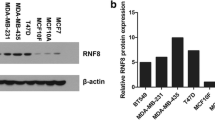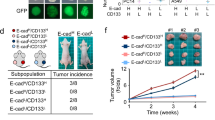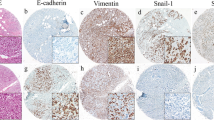Abstract
Numerous studies have shown that S100A4 acquires its metastasis-promoting effects via inducing epithelial-mesenchymal transition (EMT). However, its role and mechanism in EMT in breast cancer had not been clearly elucidated. Herein, we showed that the knockdown of S100A4 expression in breast cancer cell lines, MDA-MB-231 and MDA-MB-468, inhibited not only cell invasion ability greatly, but also the occurrence of EMT significantly. In addition, S100A4 knockdown could also decrease the expression of MMP2, a promoter and a mediator of the EMT processes in cancer. Above all, restoring the expression of MMP2 in MDA-MB-231 and MDA-MB-468 could not only rescue the invasion ability inhibited by knockdown of S100A4, but also reverse the EMT suppressed by knockdown of S100A4. In summary, our results indicated that S100A4 could promote the invasion ability of breast cancer cells via EMT, more importantly, it could participate in EMT via regulating MMP2 in breast cancer. Therefore, S100A4 could be a candidate biomarker for defining breast cancer metastasis and useful target for therapy.





Similar content being viewed by others
References
Stanley P. L. Leong, Zhen-Zhou Shen, Tse-Jia Liu, Gaurav Agarwal, Tomoo Tajima, Nam-Sun Paik, Kerstin Sandelin, Anna Derossis, Hiram Cody, William D. Foulkes. Is breast cancer the same disease in Asian and Western countries? World J Surg. 2010; 34(10): 2308–2324
Yvonne L. Michael, Nichole E. Carlson, Rowan T. Chlebowski, Mikel Aickin, Karen L. Weihs, Judith K. Ockene, Deborah J. Bowen, Cheryl Ritenbaugh. Influence of stressors on breast cancer incidence in the Women’s Health Initiative. Health Psychol. 2009; 28(2): 137–146.
Lv ZD, Kong B, Liu XP, Dong Q, Niu HT, Wang YH, et al. CXCL12 chemokine expression suppresses human breast cancer growth and metastasis in vitro and in vivo. Int J Clin Exp Pathol. 2014;7(10):6671–8.
Kong M, Hong SE. Predictive factors for supraclavicular lymph node recurrence in N1 breast cancer patients. Asian Pac J Cancer Prev. 2013;14(4):2509–14.
Rosa Mendoza ES, Moreno E, Caguioa PB. Predictors of early distant metastasis in women with breast cancer. J Cancer Res Clin Oncol. 2013;139(4):645–52.
Bill R, Christofori G. The relevance of EMT in breast cancer metastasis: correlation or causality? FEBS Lett. 2015;589(14):1577–87.
Konrad S, Stefan E, Andres Jan S, Julie S. Clinical significance of epithelial-mesenchymal transition. Clin Transl Med. 2014;3:17.
Sarah H, Genevieve H, Meghan L, Mckenna L, Shannon B, Karolina L, et al. EMT and tumor metastasis. Clin Transl Med. 2015;4:6.
Tsai JH, Yang J. Epithelial-mesenchymal plasticity in carcinoma metastasis. Genes Dev. 2013;27(20):2192–206.
Gonzalez DM, Damian M. Signaling mechanisms of the epithelial-mesenchymal transition. Sci Signal. 2014;7(344):re8.
Natarajan J, Hunter K, Mutalik VS, Radhakrishnan R. Overexpression of S100A4 as a biomarker of metastasis and recurrence in oral squamous cell carcinoma. J Appl Oral Sci. 2014;22(5):426–33.
Rasanen K, Sriswasdi S, Valiga A, Tang HY, Zhang G, Perego M, et al. Comparative secretome analysis of epithelial and mesenchymal subpopulations of head and neck squamous cell carcinoma identifies S100A4 as a potential therapeutic target. Mol Cell Proteomics. 2013;12(12):3778–92.
Martínez-Aguilar J, Clifton-Bligh R, Molloy MP. A multiplexed, targeted mass spectrometry assay of the S100 protein family uncovers the isoform-specific expression in thyroid tumours. BMC Cancer. 2015;29(15):199.
Heerboth S, Housman G, Leary M, Longacre M, Byler S, Lapinska K, et al. EMT and tumor metastasis. Clin Transl Med. 2015;4:6.
Xuan X, Li Q, Zhang Z, Du Y, Liu P. Increased expression levels of S100A4 associated with hypoxia-induced invasion and metastasis in esophageal squamous cell cancer. Tumour Biol. 2014;35(12):12535–43.
Chen M, Bresnick AR, O'Connor KL. Coupling S100A4 to Rhotekin alters Rho signaling output in breast cancer cells. Oncogene. 2013;32(32):3754–64.
Takenaga K, Nakanishi H, Wada K, Suzuki M, Matsuzaki O, Matsuura A, et al. Increased expression of S100A4, a metastasis-associated gene, in human colorectal adenocarcinomas. Clin Cancer Res. 1997;3(12 Pt 1):2309–16.
Wang H, Shi J, Luo Y, Liao Q, Niu Y, Zhang F, et al. LIM and SH3 protein 1 induces TGF-β-mediated epithelial-mesenchymal transition in human colorectal cancer by regulating S100A4 expression. Clin Cancer Res. 2014;20(22):5835–47.
Xu X, Su B, Xie C, Wei S, Zhou Y, Liu H, et al. Sonic hedgehog-Gli1 signaling pathway regulates the epithelial mesenchymal transition (EMT) by mediating a new target gene, S100A4, in pancreatic cancer cells. PLoS One. 2014;9(7):e96441.
Xue C, Plieth D, Venkov C, Xu C, Neilson EG. The gatekeeper effect of epithelial-mesenchymal transition regulates the frequency of breast cancer metastasis. Cancer Res. 2003;63:3386–94.
Cichon MA, Nelson CM, Radisky DC. Regulation of epithelial-mesenchymal transition in breast cancer cells by cell contact and adhesion. Cancer Informat. 2015;14 Suppl 3:1–13.
McConkey DJ, Choi W, Marquis L, Martin F, Williams MB, Shah J, et al. Role of epithelial-to-mesenchymal transition (EMT) in drug sensitivity and metastasis in bladder cancer. Cancer Metastasis Rev. 2009;28(3-4):335–44.
Cheng S, Lovett DH. Gelatinase A (MMP-2) is necessary and sufficient for renal tubular cell epithelial-mesenchymal transformation. Am J Pathol. 2003;162(6):1937–49.
Chantravekin Y, Koontongkaew S. Effects of ameloblastoma-associated fibroblasts on the proliferation and invasion of tumor cells. J Cancer Res Ther. 2014;10(4):1082–7.
Zhu H, Zhou X, Ma C, Chang H, Li H, Liu F, et al. Low expression of miR-448 Induces EMT and promotes invasion by regulating ROCK2 in hepatocellular carcinoma. Cell Physiol Biochem. 2015;36(2):487–98.
Hu J, Yang D, Zhang H, Liu W, Zhao Y, Lu H, et al. USP22 promotes tumor progression and induces epithelial-mesenchymal transition in lung adenocarcinoma. Lung Cancer. 2015;88(3):239–45.
Kumar S, Das A, Sen S. Extracellular matrix density promotes EMT by weakening cell-cell adhesions. Mol BioSyst. 2014;10(4):838–50.
Korol A, Pino G, Dwivedi D, Robertson JV, Deschamps PA, West-Mays JA. Matrix metalloproteinase-9-null mice are resistant to TGF-β-induced anterior subcapsular cataract formation. Am J Pathol. 2014;184(7):2001–12.
Orlichenko LS, Radisky DC. Matrix metalloproteinases stimulate epithelial-mesenchymal transition during tumor development. Clin Exp Metastasis. 2008;25(6):593–600.
Yang XC, Wang X, Luo L, Dong DH, Yu QC, Wang XS, et al. RNA interference suppression of A100A4 reduces the growth and metastatic phenotype of human renal cancer cells via NF-kB-dependent MMP-2 and bcl-2 pathway. Eur Rev Med Pharmacol Sci. 2013;17(12):1669–80.
Zhang HY, Zheng XZ, Wang XH, Xuan XY, Wang F, Li SS. S100A4 mediated cell invasion and metastasis of esophageal squamous cell carcinoma via the regulation of MMP-2 and E-cadherin activity. Mol Biol Rep. 2012;39(1):199–208.
Conflicts of interest
None
Author information
Authors and Affiliations
Corresponding author
Additional information
Han Xu and Mengquan Li contributed equally to this work.
Rights and permissions
About this article
Cite this article
Xu, H., Li, M., Zhou, Y. et al. S100A4 participates in epithelial-mesenchymal transition in breast cancer via targeting MMP2. Tumor Biol. 37, 2925–2932 (2016). https://doi.org/10.1007/s13277-015-3709-3
Received:
Accepted:
Published:
Issue Date:
DOI: https://doi.org/10.1007/s13277-015-3709-3




